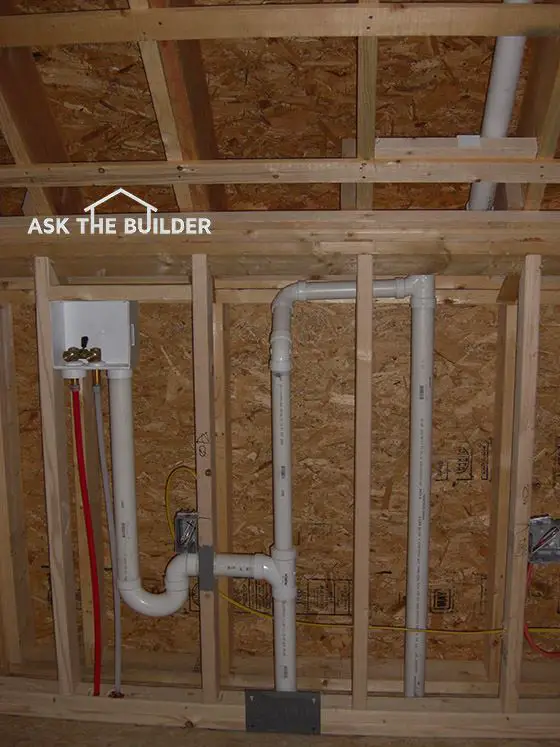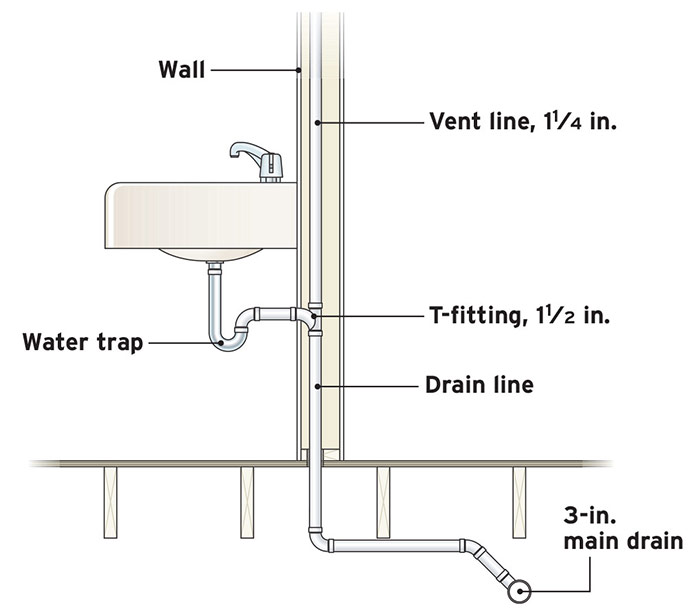We've encountered this post relating to Why Plumbing Air Vents Are Important down the page on the net and decided it made perfect sense to discuss it with you here.

Proper air flow in pipes systems is typically overlooked, yet it is critical for maintaining the capability and safety of your home's pipes. Ventilation assists control atmospheric pressure, protect against the buildup of harmful gases, and make sure the reliable elimination of waste. In this guide, we will certainly check out the value of appropriate pipes air flow, how it functions, and the advantages it brings to your plumbing system.
Recognizing Air Flow in Plumbing
Air flow in pipes refers to the network of pipelines that enable air to flow with the drainage system. These vents offer multiple functions, consisting of controling air pressure within the pipelines, protecting against sewer gases from going into the home, and aiding in the smooth flow of wastewater.
How Ventilation Functions in Pipes Equipments
Air Pressure Policy
Correct air flow preserves well balanced atmospheric pressure within the plumbing system. When water moves with pipelines, it displaces air. Without adequate ventilation, this displacement can produce unfavorable pressure, resulting in reduce drains pipes or siphoning of water from traps, which can create undesirable smells to leak into the home.
Preventing Drain Gas Accumulation
One of the most essential functions of pipes vents is to avoid sewer gases, such as methane and hydrogen sulfide, from collecting within the home. These gases can pose significant health dangers and are extremely flammable. Vent pipelines permit these gases to run away securely outdoors.
Assisting in Waste Removal
Ventilation aids in the effective removal of wastewater by preventing airlocks in the drainage system. When air can flow freely through the vents, it permits water and waste to move efficiently through the pipes, minimizing the risk of clogs and back-ups.
Sorts Of Pipes Vents
Main Stack Vent
The main stack air vent, likewise known as the air vent stack, is the key vent in a pipes system. It expands from the primary drainpipe align through the roofing system, permitting gases to escape and fresh air to go into the system.
Branch Vent
Branch vents link to the primary stack air vent and serve individual fixtures, such as sinks, toilets, and showers. These vents make certain that each component has sufficient ventilation to work effectively.
Air Admission Shutoff (AAV).
An Air Admission Valve (AAV) is a one-way valve that permits air to enter the pipes system without the requirement for a traditional air vent pipeline expanding via the roofing. AAVs are commonly utilized in improvements or areas where installing a common vent is unwise.
Indications of Poor Air Flow in Pipes.
Slow Draining Fixtures.
If your sinks, tubs, or bathrooms are draining pipes gradually, it could be a sign of poor ventilation. Poor air circulation can produce a vacuum cleaner result, making it hard for water to drain properly.
Gurgling Seems.
Gurgling noises originating from drains pipes are frequently a result of air being drawn with water traps due to negative pressure in the pipelines. This is a clear indication of insufficient air flow.
Undesirable Odors.
Drain smells inside your home are a warning that your plumbing system is not correctly ventilated. This might indicate that sewage system gases are not being properly aired vent outside, resulting in potentially dangerous conditions.
Common Air Flow Errors.
Inadequate Vent Sizing.
Utilizing small vent pipelines can cause poor air circulation and stress inequalities in the system. It's necessary to make use of vents that satisfy the specific demands of your plumbing system.
Improper Vent Placement.
Placing vents as well far from the components they offer can minimize their effectiveness. Correct placement ensures that air can move openly and efficiently via the system.
Disregarding Code Needs.
Building ordinance offer details standards for plumbing ventilation. Neglecting these codes can cause a system that stops working to operate correctly and may cause pricey repair work or health hazards.
Benefits of Proper Ventilation.
Improved System Performance.
Properly aerated pipes systems operate more successfully, with fewer obstructions, faster draining, and much less strain on the pipelines. This effectiveness extends the life-span of the pipes system.
Improved Air High Quality.
By preventing sewer gases from entering your home, correct ventilation contributes to better interior air top quality, making your living atmosphere healthier and much more comfortable.
Avoiding Water Damage.
Adequate ventilation aids protect against water from being siphoned out of traps, which can bring about sewer gases getting in the home and creating water damage in time.
Steps to Guarantee Correct Air Flow.
Consulting Plumbing Codes.
Always get in touch with neighborhood plumbing codes when developing or modifying your pipes system. These codes provide the necessary standards for appropriate airing vent and guarantee your system meets security requirements.
Normal Assessment and Upkeep.
Routine inspections can help recognize possible ventilation issues before they end up being major issues. Maintenance tasks, such as cleaning up air vent pipelines and looking for blockages, are necessary for keeping the system in good working order.
Expert Setup.
For new installments or significant adjustments, it's a good idea to employ a specialist plumbing. They have the knowledge to make sure the ventilation system is appropriately made and set up according to code.
Final thought.
Correct air flow is an important part of any type of plumbing system, making sure that it functions effectively and securely. By recognizing the relevance of ventilation, acknowledging the indicators of poor air flow, and taking actions to maintain your system, you can protect against expensive concerns and shield your home's air high quality.
4 Things You Should Know About Your Plumbing Vents
What Plumbing Vents Are
Also called a vent stack, a plumbing vent is a vertical pipe attached to your drain line that runs through your roof. The plumbing vent pipe, or plumbing air vent, removes gas and odors from your plumbing system and allows fresh air to enter the pipes, helping the water to flow out of the drain pipes.
What Plumbing Vents Do
Plumbing vents have two basic functions. One of which is to allow unpleasant smelling wastewater and sewer gasses to escape your plumbing system instead of entering your home. Plumbing vent pipes are typically located on roofs, away from windows, to ensure the fumes exit the home completely.
The other function of the plumbing vent is to move fresh air into your plumbing system. This helps move water through every plumbing fixture in your house, like toilets and sink drains. Think of the way in which you need to let a little air into the bottle as you pour soda in order to make the drink flow smoothly.
Different Types of Plumbing Vents
- True vent: This is the most common vent option. In simplest terms, a true vent is a vertical pipe attached to your drain line that exits through the roof. They often function as the main vent that other fixtures can connect to.
- Re-vent pipe or auxiliary vent: Attached to the drain line near specific plumbing fixtures, re-vent pipes run up and over to connect to the main vent.
- Common vent: Two plumbing fixtures installed on opposite sides of a wall are typically tied into the vent stack using something known as a sanitary cross.
- Wet vent: This venting option operates as a drain pipe and a vent at the same time. Wet vent drainage systems drain water from one fixture while venting the air from another. Although they’ve been used for over 100 years, wet vent systems have only recently been added to the plumbing code in many areas. If you’re planning on installing one in a bathroom remodel, make sure you check your local code prior to construction.
- Loop vent: For free-standing fixtures like kitchen island sinks, loop vents are ideal. These vent pipes run under the floor, rise from the P-trap, and create a loop inside the cabinet sink.
- Air admittance valve: An AAV is a one-way mechanical valve typically installed at the site of the plumbing fixture. AAVs allow venting to occur without having to tie into a larger venting system. They’re ideal for venting fixtures where you aren’t able to easily connect to an existing vent system.
Common Plumbing Vent Issues
Although vent pipes typically don’t have water flowing through them, they’re still subject to many typical plumbing issues. For example, clogs are one of the most common problems associated with sewer vent pipes. If your vent pipe gets clogged, all of your plumbing fixtures tied into the vent stack will be affected.
A sink with a slow drain that bubbles and gurgles or a strong sewage smell around your toilet are both indicators that your toilet vent pipe is clogged. Because most vent pipes exit through the roof, old leaves, twigs or even a bird’s nest could be clogging the pipe.
Clogs in your vent pipe system cause a buildup of negative pressure, meaning that water won’t be able to flow out of your home very well. It’s similar to putting your finger over the opening of a straw to trap water inside. When you remove your finger, the water is able to flow out of the straw.
If you suspect you have any blockage in your vent, make sure you have a professional come examine the situation. Left unchecked, a blocked air vent can lead to other costly repairs, like leaks and sediment buildup.
Under Pressure
Pipe vents are essential aspects of a home’s plumbing system. Owning a home means learning about all sorts of things you never put much thought into before. But by understanding as much as you can about the important systems of your home, you can keep those budgets intact and those anxiety levels low.
https://www.homeserve.com/en-us/blog/home-improvement/plumbing-vents/

We hope you enjoyed our piece about What Are Plumbing Vents and Why Are They Important?. Thanks a lot for finding the time to read our article post. In case you appreciated our blog entry plz remember to share it. Thank you so much for taking the time to read it.
Call Today
Comments on “Why Proper Ventilation Is Important in Plumbing Systems”